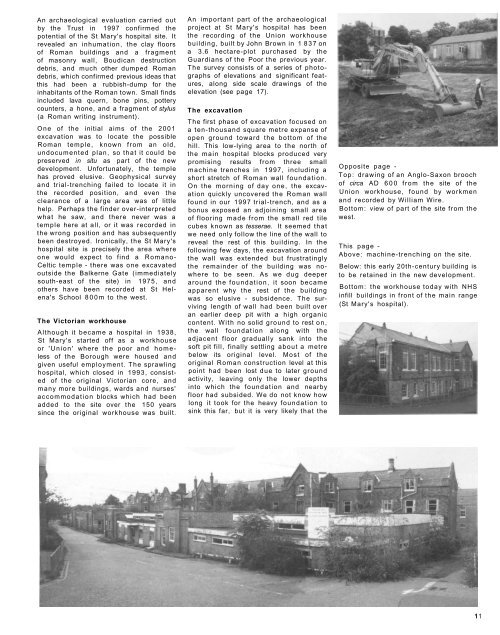The Colchester Archaeologist 2002 - Colchester Archaeological Trust
The Colchester Archaeologist 2002 - Colchester Archaeological Trust
The Colchester Archaeologist 2002 - Colchester Archaeological Trust
Create successful ePaper yourself
Turn your PDF publications into a flip-book with our unique Google optimized e-Paper software.
An archaeological evaluation carried out<br />
by the <strong>Trust</strong> in 1997 confirmed the<br />
potential of the St Mary's hospital site. It<br />
revealed an inhumation, the clay floors<br />
of Roman buildings and a fragment<br />
of masonry wall, Boudican destruction<br />
debris, and much other dumped Roman<br />
debris, which confirmed previous ideas that<br />
this had been a rubbish-dump for the<br />
inhabitants of the Roman town. Small finds<br />
included lava quern, bone pins, pottery<br />
counters, a hone, and a fragment of stylus<br />
(a Roman writing instrument).<br />
One of the initial aims of the 2001<br />
excavation was to locate the possible<br />
Roman temple, known from an old,<br />
undocumented plan, so that it could be<br />
preserved in situ as part of the new<br />
development. Unfortunately, the temple<br />
has proved elusive. Geophysical survey<br />
and trial-trenching failed to locate it in<br />
the recorded position, and even the<br />
clearance of a large area was of little<br />
help. Perhaps the finder over-interpreted<br />
what he saw, and there never was a<br />
temple here at all, or it was recorded in<br />
the wrong position and has subsequently<br />
been destroyed. Ironically, the St Mary's<br />
hospital site is precisely the area where<br />
one would expect to find a Romano-<br />
Celtic temple - there was one excavated<br />
outside the Balkerne Gate (immediately<br />
south-east of the site) in 1975, and<br />
others have been recorded at St Helena's<br />
School 800m to the west.<br />
<strong>The</strong> Victorian workhouse<br />
Although it became a hospital in 1938,<br />
St Mary's started off as a workhouse<br />
or 'Union' where the poor and homeless<br />
of the Borough were housed and<br />
given useful employment. <strong>The</strong> sprawling<br />
hospital, which closed in 1993, consisted<br />
of the original Victorian core, and<br />
many more buildings, wards and nurses'<br />
accommodation blocks which had been<br />
added to the site over the 150 years<br />
since the original workhouse was built.<br />
An important part of the archaeological<br />
project at St Mary's hospital has been<br />
the recording of the Union workhouse<br />
building, built by John Brown in 1 837 on<br />
a 3.6 hectare-plot purchased by the<br />
Guardians of the Poor the previous year.<br />
<strong>The</strong> survey consists of a series of photographs<br />
of elevations and significant features,<br />
along side scale drawings of the<br />
elevation (see page 17).<br />
<strong>The</strong> excavation<br />
<strong>The</strong> first phase of excavation focused on<br />
a ten-thousand square metre expanse of<br />
open ground toward the bottom of the<br />
hill. This low-lying area to the north of<br />
the main hospital blocks produced very<br />
promising results from three small<br />
machine trenches in 1997, including a<br />
short stretch of Roman wall foundation.<br />
On the morning of day one, the excavation<br />
quickly uncovered the Roman wall<br />
found in our 1997 trial-trench, and as a<br />
bonus exposed an adjoining small area<br />
of flooring made from the small red tile<br />
cubes known as tesserae. It seemed that<br />
we need only follow the line of the wall to<br />
reveal the rest of this building. In the<br />
following few days, the excavation around<br />
the wall was extended but frustratingly<br />
the remainder of the building was nowhere<br />
to be seen. As we dug deeper<br />
around the foundation, it soon became<br />
apparent why the rest of the building<br />
was so elusive - subsidence. <strong>The</strong> surviving<br />
length of wall had been built over<br />
an earlier deep pit with a high organic<br />
content. With no solid ground to rest on,<br />
the wall foundation along with the<br />
adjacent floor gradually sank into the<br />
soft pit fill, finally settling about a metre<br />
below its original level. Most of the<br />
original Roman construction level at this<br />
point had been lost due to later ground<br />
activity, leaving only the lower depths<br />
into which the foundation and nearby<br />
floor had subsided. We do not know how<br />
long it took for the heavy foundation to<br />
sink this far, but it is very likely that the<br />
Opposite page -<br />
Top: drawing of an Anglo-Saxon brooch<br />
of circa AD 600 from the site of the<br />
Union workhouse, found by workmen<br />
and recorded by William Wire.<br />
Bottom: view of part of the site from the<br />
west.<br />
This page -<br />
Above: machine-trenching on the site.<br />
Below: this early 20th-century building is<br />
to be retained in the new development.<br />
Bottom: the workhouse today with NHS<br />
infill buildings in front of the main range<br />
(St Mary's hospital).<br />
11

















